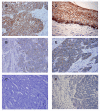Significance of Twist expression and its association with E-cadherin in esophageal squamous cell carcinoma
- PMID: 20025748
- PMCID: PMC2808309
- DOI: 10.1186/1756-9966-28-158
Significance of Twist expression and its association with E-cadherin in esophageal squamous cell carcinoma
Abstract
Background: Twist is a basic helix-loop-helix (bHLH) transcriptional factor that has been identified to play an important role in epithelial-mesenchymal transition (EMT)-mediated metastasis through the regulation of E-cadherin expression. However, few authors have examined the expression of Twist and E-cadherin and their prognostic value in patients with esophageal squamous cell carcinoma (ESCC). The purpose of this study is to evaluate the clinical significance of Twist and E-cadherin expression in ESCC.
Methods: We immunohistochemically investigated the relationship between their expression and clinicopathological factors including prognosis in surgical specimens of primary tumors in 166 patients with ESCC.
Results: The expression rate of high Twist was 42.0% and that of preserved E-cadherin was 40.4%. The expression of high Twist and reduced E-cadherin was significantly associated with depth of tumor invasion, lymph node metastasis, distant nodal metastasis, stage and lymphatic invasion, and poor prognosis. High Twist expression significantly correlated with reduced E-cadherin expression. In the preserved E-cadherin group, the 5-year survival rate was better for patients who were low for Twist expression than for those who were high for Twist expression. Multivariate analysis indicated that the combination of low Twist and preserved E-cadherin expression was an independent prognostic factor along with tumor depth, distant nodal metastasis and E-cadherin expression.
Conclusions: Evaluation of Twist and E-cadherin expressions should be useful for determining tumor properties, including prognosis, in patients with ESCC.
Figures




Similar articles
-
Snail plays a key role in E-cadherin-preserved esophageal squamous cell carcinoma.Oncol Rep. 2007 Mar;17(3):517-23. Oncol Rep. 2007. PMID: 17273727
-
ADAMTS-6 is a predictor of poor prognosis in patients with esophageal squamous cell carcinoma.Exp Mol Pathol. 2018 Apr;104(2):134-139. doi: 10.1016/j.yexmp.2018.02.004. Epub 2018 Feb 21. Exp Mol Pathol. 2018. PMID: 29475036
-
Slug Expression in the E-cadherin preserved tumors is related to prognosis in patients with esophageal squamous cell carcinoma.Clin Cancer Res. 2005 Feb 1;11(3):1174-80. Clin Cancer Res. 2005. PMID: 15709186
-
Twist, an independent prognostic marker for predicting distant metastasis and survival rates of esophageal squamous cell carcinoma patients.Clin Exp Metastasis. 2009;26(8):1025-32. doi: 10.1007/s10585-009-9292-5. Epub 2009 Oct 9. Clin Exp Metastasis. 2009. PMID: 19816777
-
Relationship between TWIST expression and epithelial-mesenchymal transition of oesophageal squamous cell carcinoma.Cell Biol Int. 2012 Jun 1;36(6):571-7. doi: 10.1042/CBI20100195. Cell Biol Int. 2012. PMID: 22360285
Cited by
-
Molecules involved in epithelial-mesenchymal transition and epithelial-stromal interaction in phyllodes tumors: implications for histologic grade and prognosis.Tumour Biol. 2012 Jun;33(3):787-98. doi: 10.1007/s13277-011-0296-9. Epub 2011 Dec 29. Tumour Biol. 2012. PMID: 22203494
-
MEIS1 knockdown may promote differentiation of esophageal squamous carcinoma cell line KYSE-30.Mol Genet Genomic Med. 2019 Jul;7(7):e00746. doi: 10.1002/mgg3.746. Epub 2019 May 14. Mol Genet Genomic Med. 2019. PMID: 31090196 Free PMC article.
-
Twist and miR-34a are involved in the generation of tumor-educated myeloid-derived suppressor cells.Int J Mol Sci. 2013 Oct 14;14(10):20459-77. doi: 10.3390/ijms141020459. Int J Mol Sci. 2013. PMID: 24129179 Free PMC article.
-
TWIST1 is expressed in colorectal carcinomas and predicts patient survival.PLoS One. 2011 Mar 28;6(3):e18023. doi: 10.1371/journal.pone.0018023. PLoS One. 2011. PMID: 21464926 Free PMC article.
-
Ubiquitin carboxy-terminal hydrolase L1 may be involved in the development of mammary phyllodes tumors.Virchows Arch. 2013 Feb;462(2):155-61. doi: 10.1007/s00428-012-1366-0. Epub 2013 Jan 5. Virchows Arch. 2013. PMID: 23291960
References
-
- Natsugoe S, Uchikado Y, Okumura H, Matsumoto M, Setoyama T, Tamotsu K, Kita Y, Sakamoto A, Owaki T, Ishigami S, Aikou T. Snail plays a key role in E-cadherin-preserved esophageal squamous cell carcinoma. Oncol Rep. 2007;17:517–523. - PubMed
-
- Uchikado Y, Natsugoe S, Okumura H, Setoyama T, Matsumoto M, Ishigami S, Aikou T. Slug Expression in the E-cadherin preserved tumors is related to prognosis in patients with esophageal squamous cell carcinoma. Clin Cancer Res. 2005;11:1174–1180. - PubMed
Publication types
MeSH terms
Substances
LinkOut - more resources
Full Text Sources
Medical

